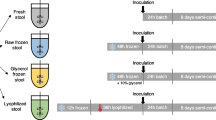Summary
To assess the influence of anaerobic bacterial heat production in human stools as a confounding factor in postmortem rectal temperature measurements, in vitro experiments were carried out with human stools incubated at 37°C for 6h and at decreasing temperatures simulating a postmortem body cooling. Although a statistical significant heat production was observed, it was not relevant enough to explain a postmortem temperature plateau or a substantial rise in the postmortem body temperature. The experiments suggest that stools merely reflect the environmental thermal changes rather than producing bias and confounding by a bacterial heat production.
Zusammenfassung
Proben menschlicher Faeces wurden anaërob für 6h bei 37°C und bei abnehmenden Temperaturen in vitro untersucht, um festzustellen, ob eine etwaige postmortale Wärmeproduktion in den Exkrementen einen Einfluß haben kann bei postmortalen rektalen Temperaturmessungen. Obwohl eine signifikante Wärmeproduktion beobachtet wurde, reicht sie nicht aus, um ein postmortales Temperaturplateau oder eine Zunahme der Körpertemperatur zu erklären. Die Experimente zeigen, daß die Faecesproben vielmehr die durch Umgebungsfaktoren bestimmte Temperaturänderungen widerspiegeln, als daß sie aufgrund ihrer bakteriellen Wärmeproduktion zu Irrtümern und Fehlern bei der postmortalen Temperaturmessung führen.
Similar content being viewed by others
References
Brown A, Marshall T (1974) Body temperature as a means of estimating the time of death. J Forensic Sci 4:125–132
Brown A, Hicks B, Knight B, Nokes L (1985) Determination of time since death using the double exponential cooling model. Med Sci Law 25:223–227
Henßge C (1979) Die Präzision von Todeszeitschätzungen durch die mathematische Beschreibung der rektalen Leichenabkühlung. Z Rechtsmed 83:49–67
Henßge C (1981) Todeszeitschätzungen durch die mathematische Beschreibung der rektalen Leichenabkühlung unter verschiedenen Abkühlungsbedingungen. Z Rechtsmed 87:147–178
Henßge C, Beckmann E, Wischhusen F, Brinkmann B (1984) Todeszeitbestimmung durch Messung der zentralen Hirntemperatur. Z Rechtsmed 93:1–22
Hutchins G (1985) Body temperature is elevated in the early postmortem period. Hum Pathol 16:560–561
James W, Knight B (1965) Errors in estimating time since death. Med Sci Law 5:111–116
Lundquist F (1956) Physical and chemical methods for the estimation of the time of death. Acta Med Leg Soc (Liège) 9:205–213
Lyle H, Cleveland F (1956) Determination of the time of death by body heat loss. J Forensic Sci 1:11–23
Madea B, Henßge C (1985) Historisches zur Todeszeitbestimmung. Z Rechtsmed 95:19–25
Marshall T (1962a) Estimating the time of death. The use of the cooling formula in the study of postmortem body cooling. J Forensic Sci 7:189–210
Marshall T (1962b) Estimating the time of death. The use of body temperature in estimating the time of death. J Forensic Sci 7:211–221
Marshall T (1969) The use of body temperature in estimating the time of death and its limitations. Med Sci Law 9:178–182
Marshall T, Hoare F (1962) Estimating the time of death. The rectal cooling after death and its mathematical expression. J Forensic Sci 7:56–81
Nokes L, Hicks B, Knight B (1985) The postmortem temperature plateau: Fact or fiction? Med Sci Law 25:263–264
Rainy H (1869) On the cooling of dead bodies as indicating the length of time that has elapsed since death. Glasgow Med J 1:323–330
Reimann W (1968) Über den Auskühlmodus der Leiche. Beitr Gerichtl Med 24:57–62
Seydeler R (1869) Nekrothermometrie. Prag. Vierteljahresschr 104:137–148
Shapiro H (1965) The postmortem temperature plateau. J Forensic Sci 12:137–141
Simonsen J, Voigt J, Jeppesen N (1977) Determination of the time of death by continuous postmortem temperature measurements. Med Sci Law 17:112–122
Author information
Authors and Affiliations
Rights and permissions
About this article
Cite this article
Hooft, P., van de Voorde, H. The role of intestinal bacterial heat production in confounding postmortem temperature measurements. Z Rechtsmed 102, 331–336 (1989). https://doi.org/10.1007/BF00200222
Received:
Issue Date:
DOI: https://doi.org/10.1007/BF00200222




